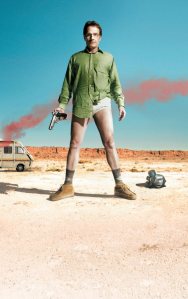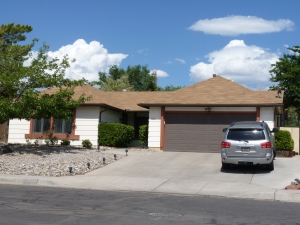The Materiality of Desperation: An Archaeology of Breaking Bad
 The Albuquerque Convention and Visitors Bureau might be justifiably conflicted by the popularity of Breaking Bad, the series detailing the life of a suburban Albuquerque methamphetamine producer. A tale of a chemistry teacher turned meth dealer, the series is an unsettling moral narrative about a milquetoast’s descent into evil, but it is also a compelling visualization of the relationship between material culture and contemporary desperation. Breaking Bad paints a grim picture of Albuquerque as a prosaic, colorless landscape, imagining how commonplace suburban tracts and the southwestern desert appear in the desperate gaze of a substratum of drug users and dealers, their naïve neighbors, and an audience that anxiously contemplates its own desperation and moral plasticity. Breaking Bad’s Albuquerque is a coarse place populated by disagreeable if not outright repulsive people whose desperation and conflicted morality are heightened by a harsh material aesthetic.
The Albuquerque Convention and Visitors Bureau might be justifiably conflicted by the popularity of Breaking Bad, the series detailing the life of a suburban Albuquerque methamphetamine producer. A tale of a chemistry teacher turned meth dealer, the series is an unsettling moral narrative about a milquetoast’s descent into evil, but it is also a compelling visualization of the relationship between material culture and contemporary desperation. Breaking Bad paints a grim picture of Albuquerque as a prosaic, colorless landscape, imagining how commonplace suburban tracts and the southwestern desert appear in the desperate gaze of a substratum of drug users and dealers, their naïve neighbors, and an audience that anxiously contemplates its own desperation and moral plasticity. Breaking Bad’s Albuquerque is a coarse place populated by disagreeable if not outright repulsive people whose desperation and conflicted morality are heightened by a harsh material aesthetic.

Jesse’s apartment apparently was available for rent when this picture was taken (image Paul Varvaez)
Breaking Bad’s account of cancer-ridden high school teacher Walter White revolves around moral relativity and unravels a series of grim crises played out against the backdrop of Albuquerque. Breaking Bad’s premise has no self-evident aesthetic: unlike a series like Mad Men—which is perhaps only about style—Breaking Bad dissects a self-loathing underachiever who descends into crime, desperate to pay for medical treatment before embracing his own ethical darkness. The series provides little moral clarity distinguishing between good and evil, and its characters’ free will results in ethically problematic choices that elicit an uneasy sympathy for the likes of Walter White. The central material dimension of Breaking Bad’s aesthetic is a familiar harshness that reaches into faceless suburbs, inner-city neighborhoods, and vacant expanses of desert. Most Breaking Bad spaces—Mesa Credit Union, the Octopus car wash, the Crossroads Motel, Los Pollos Hermanos—exist in every community. The places that appear in Breaking Bad are likewise not at all atypical of many more communities, ranging from the abandoned spaces (e.g., the hotel where Walter did his first deal); streets and parking lots (e.g., the corner where Combo was killed); grocery stores (e.g., Hi-Lo Market), and a range of homes including modest places (e.g., Jesse and Jane’s rental), charmless condos (Walt’s temporary home), a large home in a settled neighborhood (e.g. the Pinkmans’ home), and the Whites’ commonplace suburban home.
The settings aren’t necessarily unsightly as much as they are simply banal and represent nothing especially distinctive architecturally that makes Breaking Bad’s Albuquerque a “place.” Albuquerque grew very rapidly during and after World War II, expanding 173% between 1940 and 1950 (and doubling again between 1950 and 1960), so the architectural fabric contains a significant amount of Cold War and 1960’s architecture like the retail spaces and suburban homes dotting Walter White’s neighborhood. The Whites’ own three-bedroom home, for instance, is a standardized circa 1960 residence adorned with period furnishings like 1970’s living room curtains, a crocheted afghan sofa cover likely from the same moment, plates on the wall, an artificial Tiffany style dining room lamp, and family pictures that appear to have been taken by Olan Mills in the 1970’s. In another setting this might be taken as self-conscious retro parody, but in the Whites’ hands it appears instead to be a sincere show of style. Walter White himself shared that chronologically misplaced fashion for much of the series—a nerd look in plaid shirt, khaki jacket, chukka boots, and tighty-whiteys—that made it easier to sympathize with him before embracing Heisenberg’s black hat and willfully descending into evil.
Jesse Pinkman’s RV invokes its own inelegant aesthetic, a lumbering, exhausted behemoth whose dreams of family vacations apparently crumbled into its life as a meth lab cooking in the baked desert. The almost-nerdy RV was one of Breaking Bad’s most powerful aesthetic symbols in the series’ first season; Walter White graced the cover of the first season DVD set in his ill-fitting white boxers standing in the midst of the desert with the RV in the background trailing meth exhaust from its chimney.
The cityscape of warehouse ruins, car washes, and urban neighborhoods are perhaps a predictable visual stage for a moral narrative exploring the meth trade. New Mexico makes its presence most clear in Breaking Bad’s semi-arid, sun-drenched landscapes, and the series routinely situates the narrative in the scorched desert. Faraway shots of human figures dwarfed by the expansive New Mexican landscape theatrically exaggerate Albuquerque’s flat expanses, rugged mountains, and impressive skylines. The desert landscape is an especially compelling stage for a story about desperation; Breaking Bad cameras often follow cars moving across the sweeping spaces, their drivers in silent deliberation. Meth users and rural poverty are especially visually compelling on this baked desert landscape stripped of substantial vegetation and covered in a thin veneer of windswept dirt.

You can have your car washed at the A1A car wash, which is the Octopus car wash in everyday life (image John Phelan)
Breaking Bad’s landscape is quite unlike the lush Southeastern spaces on The Walking Dead, and the apocalypse survivors’ desperation is qualitatively different from that in Albuquerque; the apocalypse’s survivors are fueled by a fundamental will to live, and the landscape is not an essential rhetorical mechanism to secure an audience’s sympathy. Breaking Bad casts a less straightforward moral narrative in which the grim city and unforgiving desert are important material dimensions of a tale amplifying the series’ unsettling focus on human desperation.
Images
Jesse’s Apartment image, and Walter White’s house image from Paul Narvaez
Octopus Car Wash Image and Twisters image from John Phelan
Posted on August 10, 2013, in Uncategorized and tagged breaking bad. Bookmark the permalink. 1 Comment.






Reblogged this on The Student Becomes The Teacher.